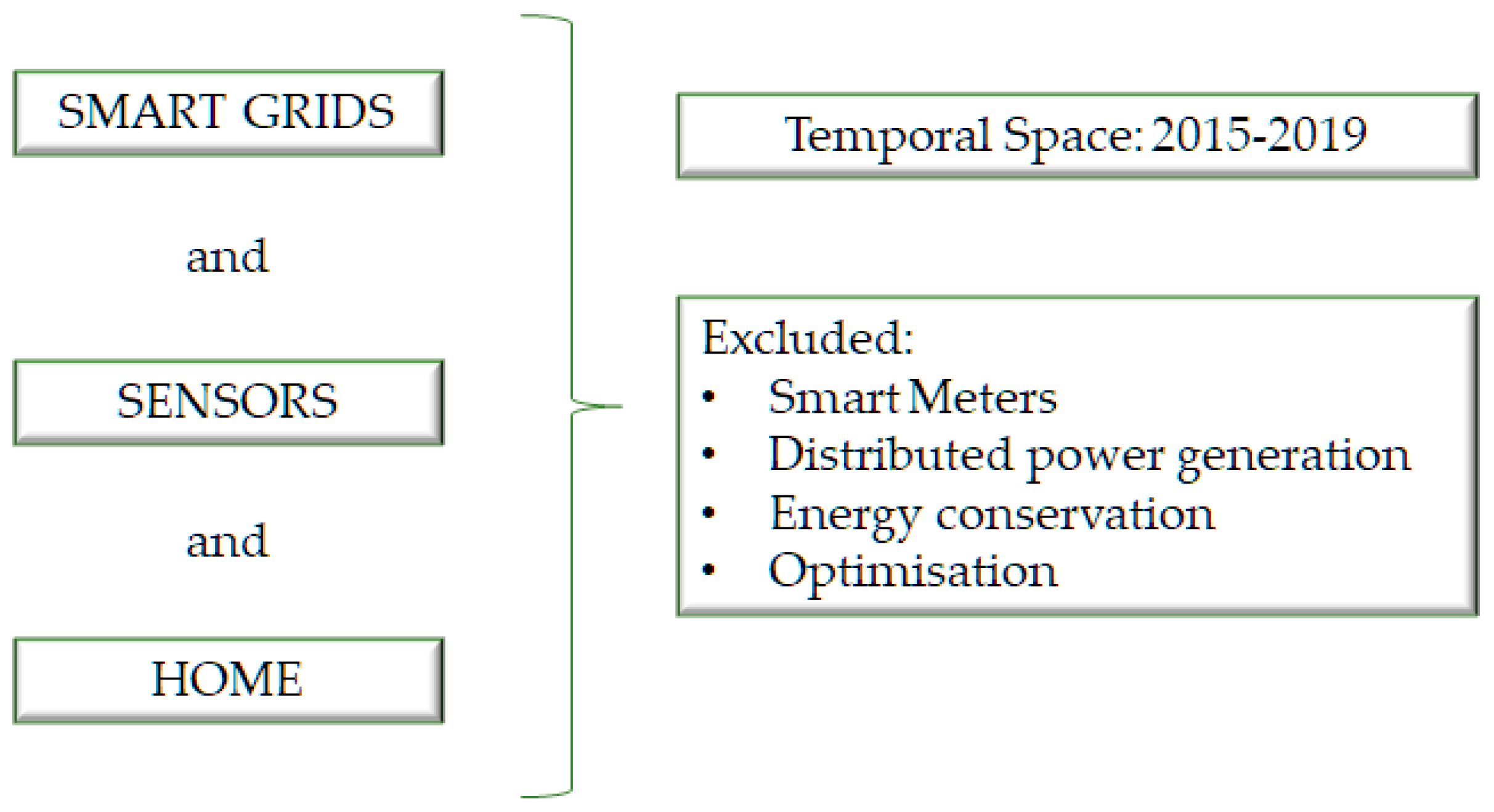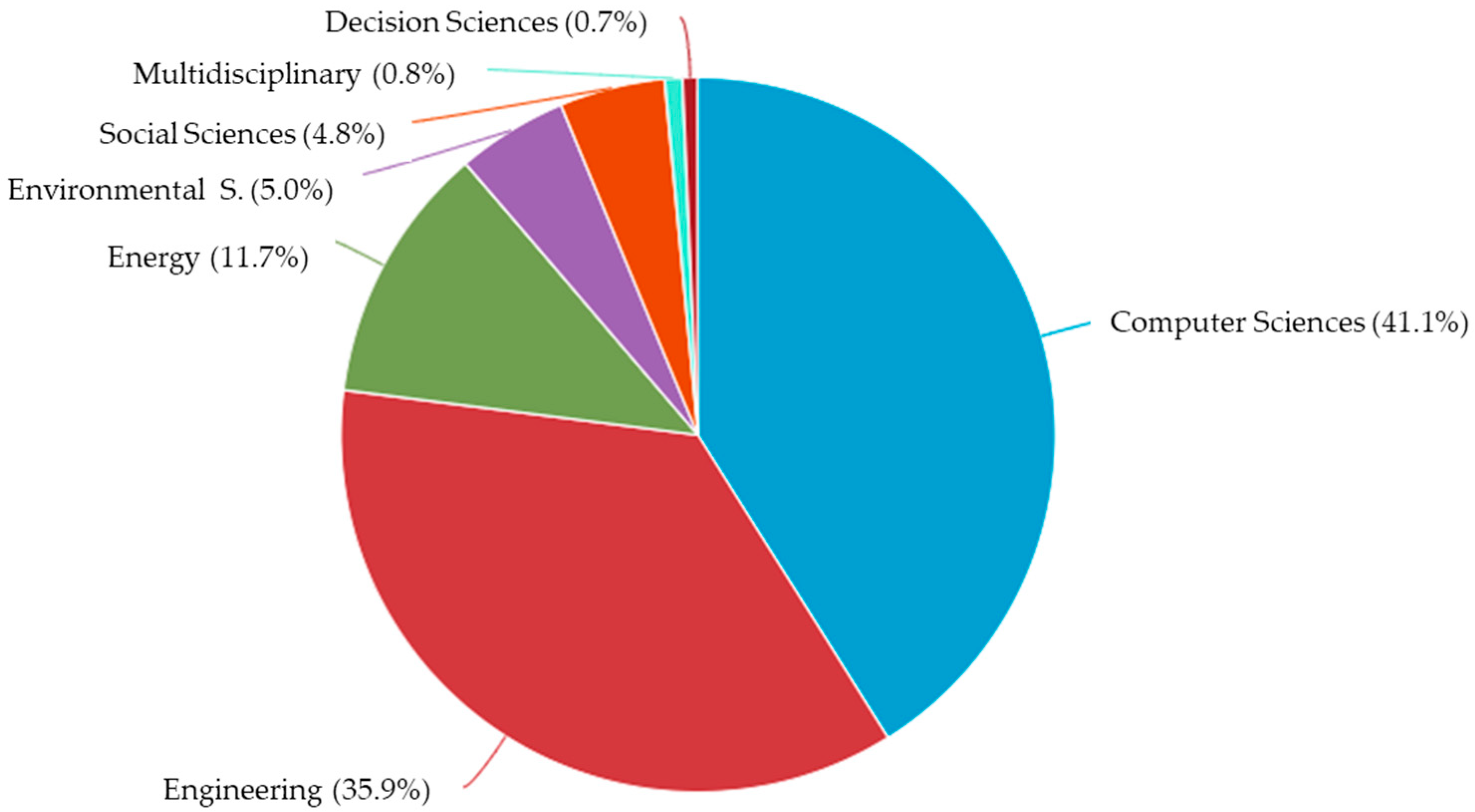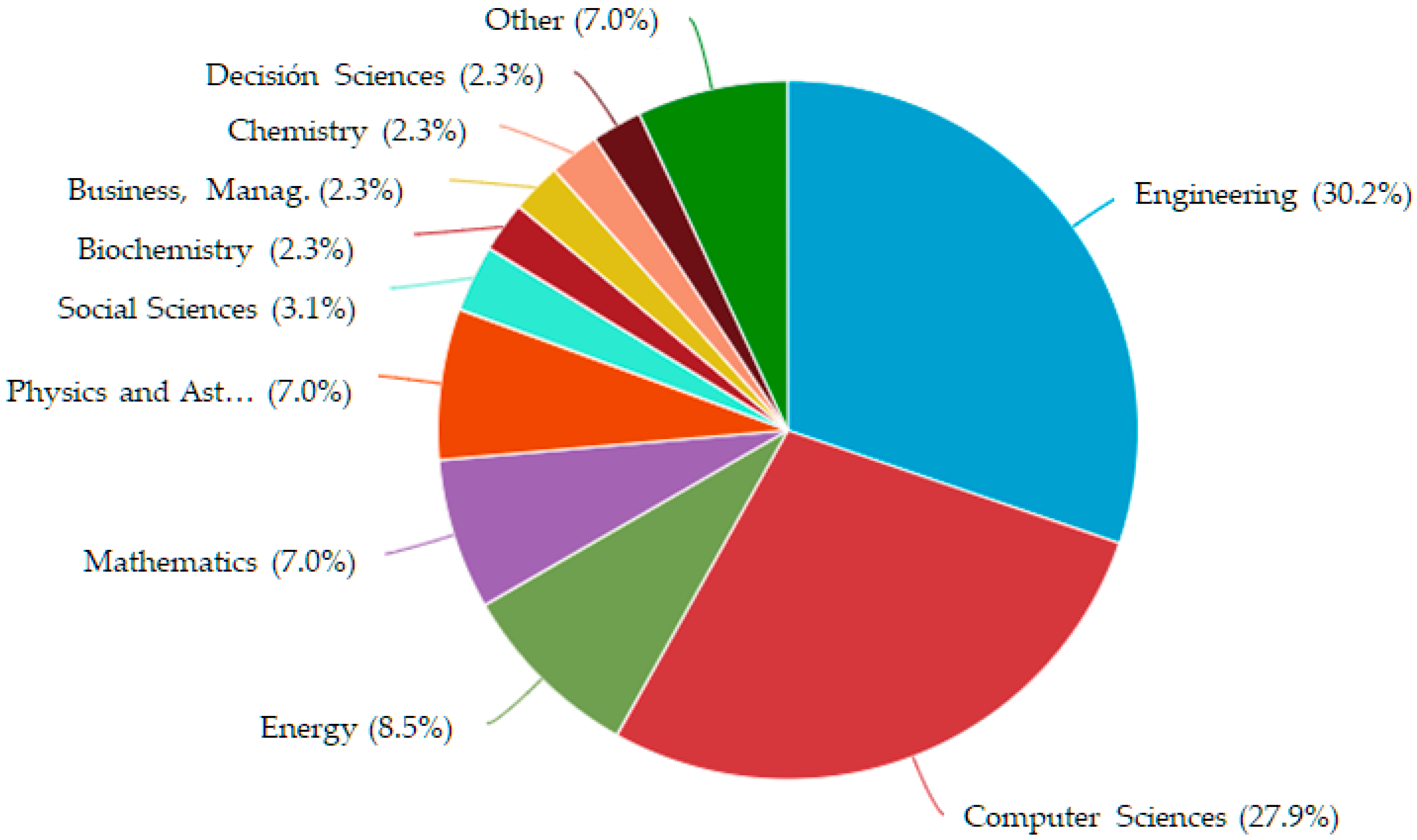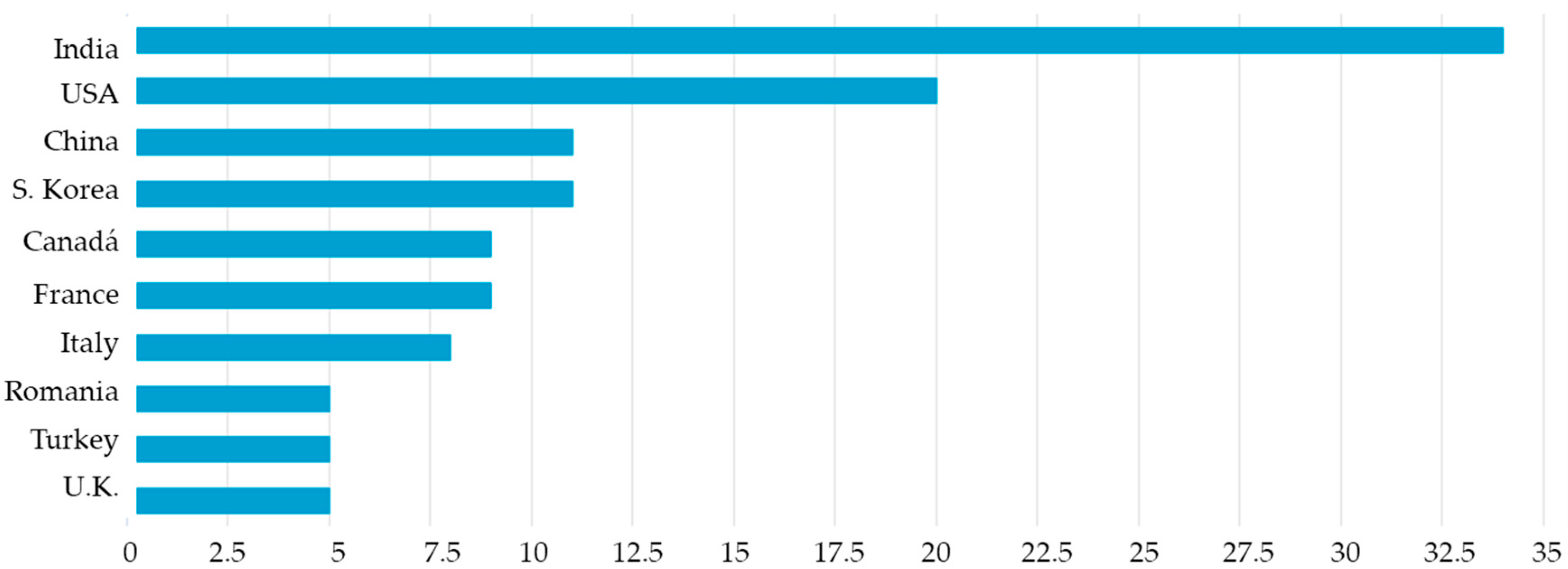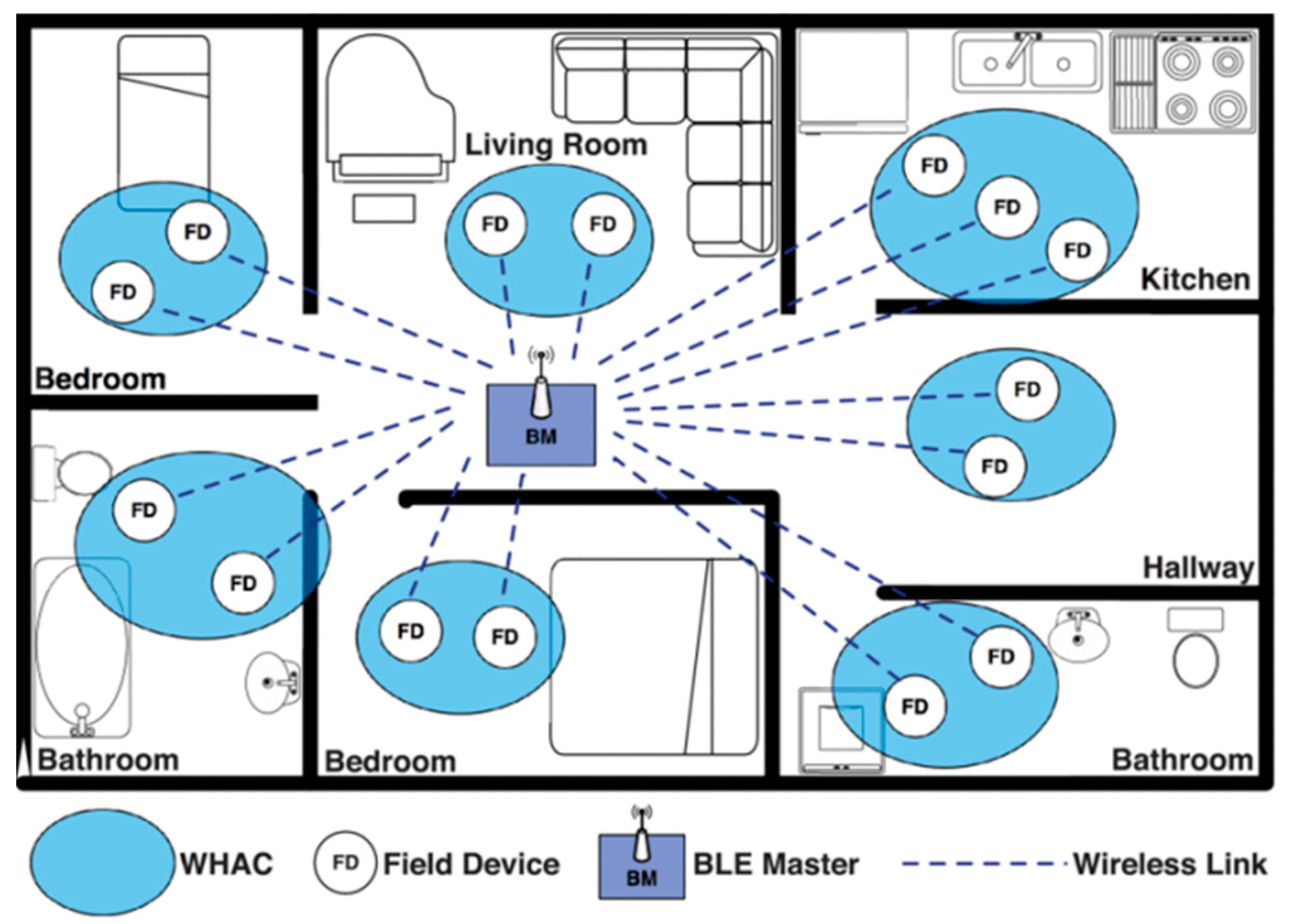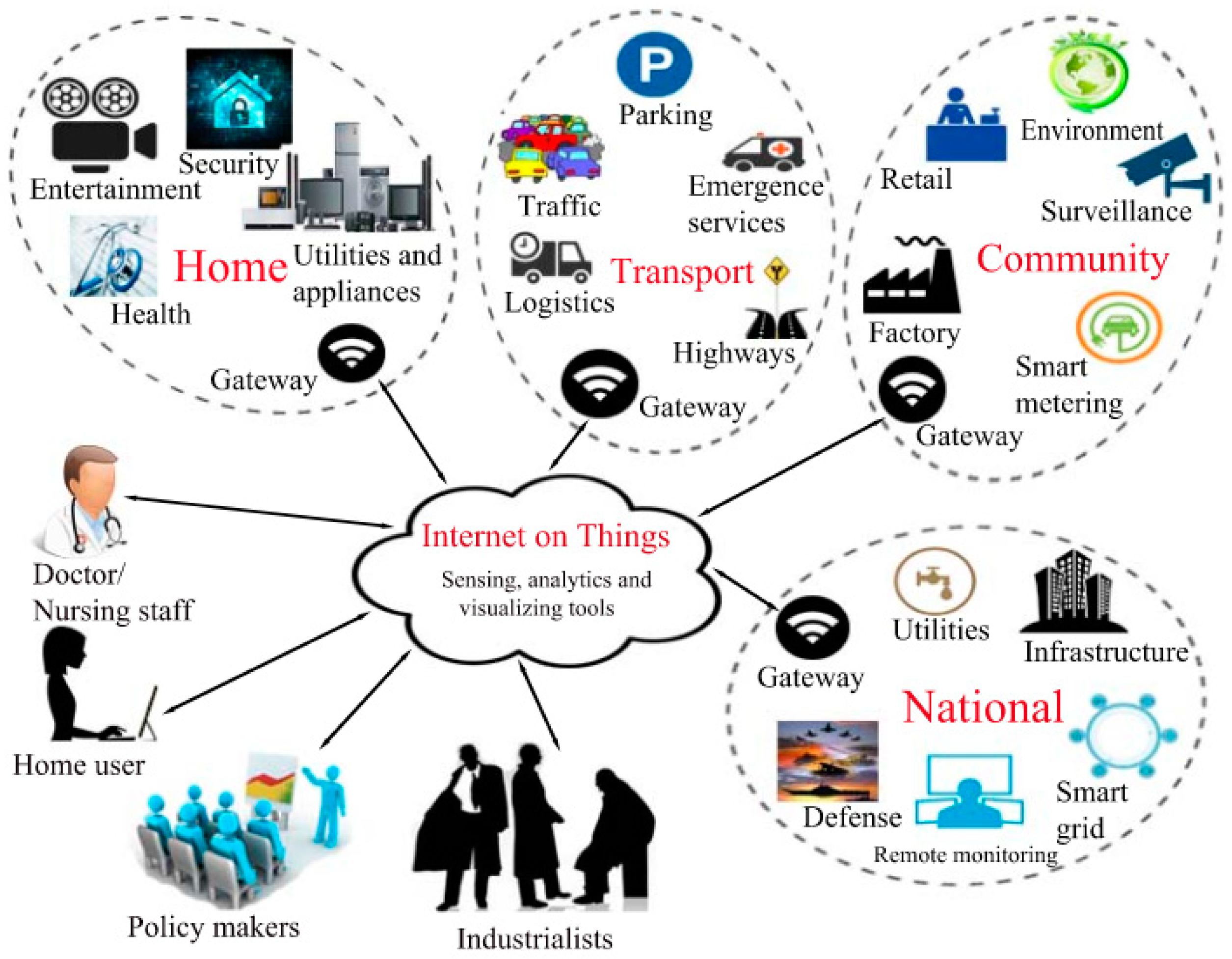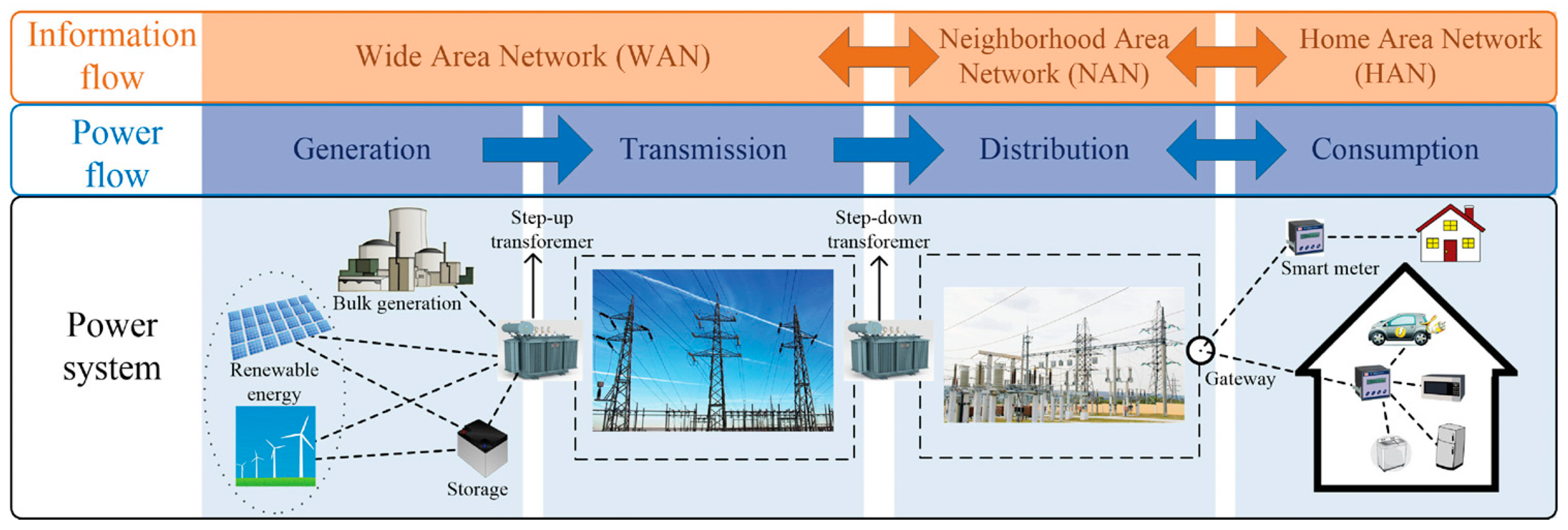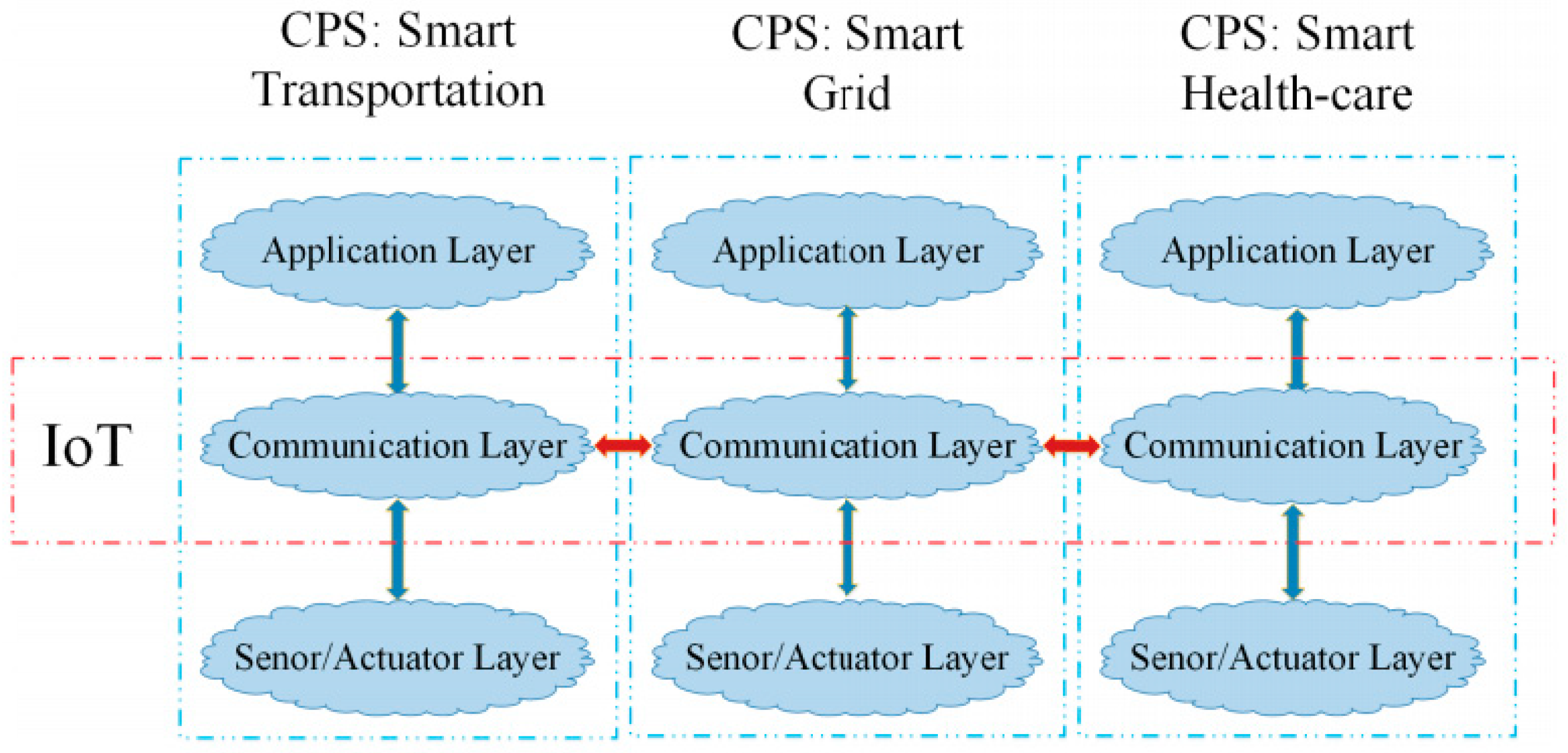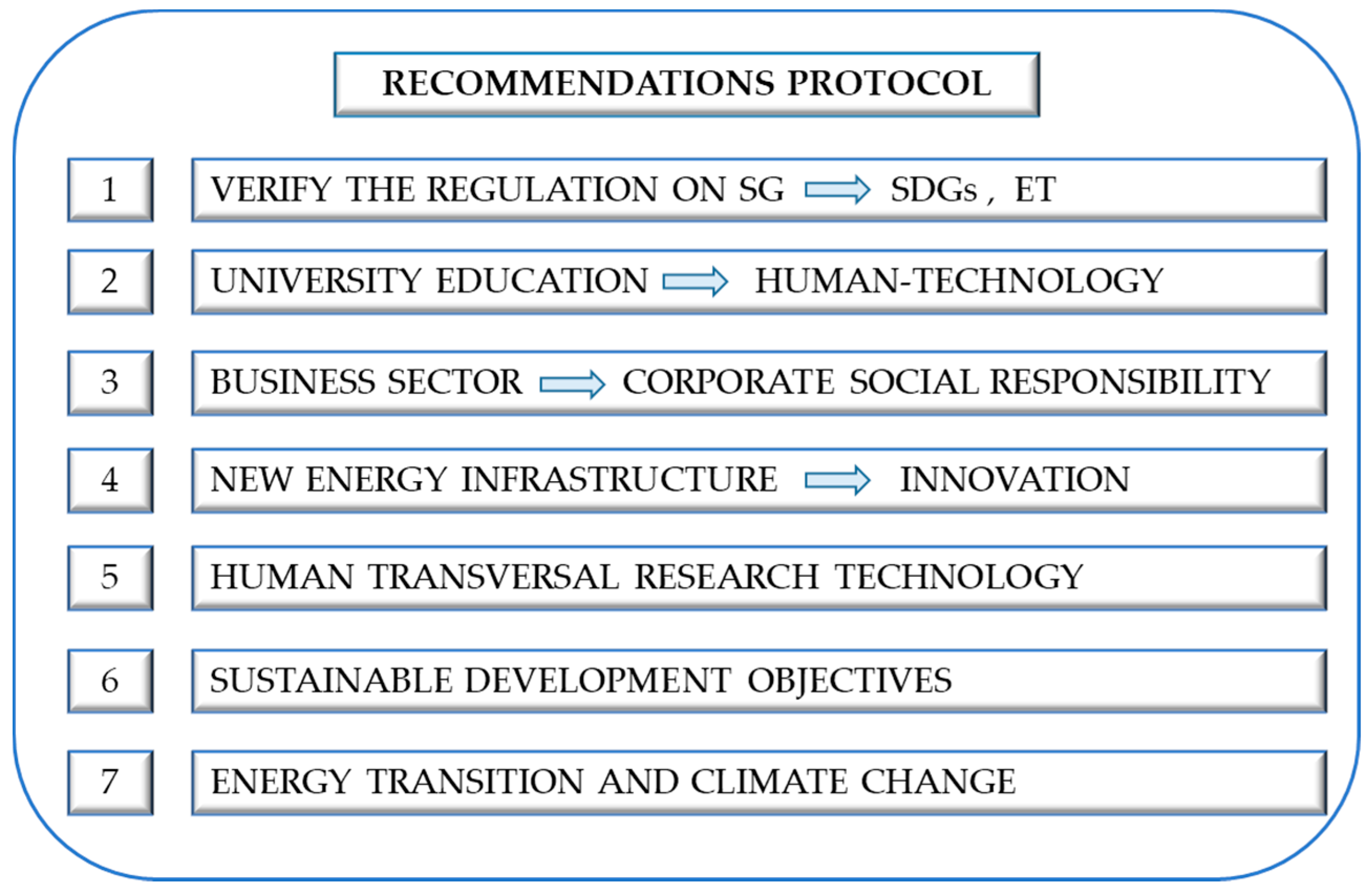1. Introduction
The design of electrical installations in a given environment poses a challenge for the improvement of energy management in our society. In the year 2019, one of the main objectives of the United Nations Climate Change Conference–COP25–held in Madrid was the development and transfer of technology to achieve a sustainable evolution of energy consumption worldwide, with the main objective of reducing greenhouse gas emissions [
1].
Today, there is a growing need for society to take care of its health by integrating the use of technology and numerous studies and research efforts offer interesting works on this topic [
2,
3]. The technology that we design and build in intelligent environments must be a climate-focused technology; that is, technological developments must drive energy consumption through renewable sources, control and measure consumption, reduce greenhouse gas emissions, and alert and prevent inappropriate energy consumption. In short, household technologies should integrate the processes of energy efficiency and environmental sustainability.
Electrical and energy networks in general are designed, planned, and installed with the objective of providing high-quality electricity supply to users. This energy travels enormous distances to reach the final point, which is the consumer. People are essential in this scenario and play a key role in interacting with the energy networks when it comes to designing better installations and improving quality.
The Smart Grid is a modern intelligent network adapted to a new global paradigm. Intelligent systems bring together energy and information and communication technologies, improving performance, quality, generation, transmission, distribution, and marketing services [
4,
5].
Regarding the influence of intelligent networks in the transformation of human activities, it is essential to know the resources and systems of sensors, IoT and, in general, the devices that improve people’s quality of life. Today, there is a growing need for society to take care of its health by integrating the use of technology. Human Activity Recognition (HAR) allows monitoring of people’s quality of life and, in time, more features and functionalities emerge in this area, relying on a wide repertoire of hardware and software components. Proof of this is the implementation of several solutions in indoor environments, which capture the data generated from people’s interactions with an intelligent environment [
6]. Data collected from heterogeneous sensors implemented in intelligent environments or from sensors connected to the body (wearables) are stored in datasets [
3] and the information obtained from intelligent devices is integrated into a larger set, the intelligent network that brings together an environment, a community, a city, and, in general, a joint strategy to improve the quality of technology and life in our society.
In 2010, the Conference of the Parties, the supreme decision-making body of the United Nations Framework Convention on Climate Change, established the Technology Executive Committee (TEC) with the objective of accelerating and enhancing the development and transfer of climate technology. This committee consists of 20 experts representing developed and developing countries. The Technology Executive Committee analyses climate technology issues and develops balanced policy recommendations, supporting countries to accelerate action on Climate Change (
Figure 1). The Technology Executive Committee brings together a range of institutions, non-governmental organisations, government experts, the United Nations, and others [
7].
In 2018, the European Commission published the document: “A Clean Planet for all”. A European strategic long-term vision for a prosperous, modern, competitive, and climate-neutral economy, in which it presented a strategy for the transition to a zero-net-emission economy in 2050. According to the European Commission, the energy system of the future will integrate the systems and markets for electricity, natural gas, air conditioning, and mobility, with smart grids that put citizens at the centre [
8].
Technology, and its development, is not only an effective tool in the fight against climate change, but it is also an essential mechanism for the evolution of life on earth and the improvement of human health and the condition of the planet in general. Technological design in this context will be key to the future of humanity.
The technological design of the environments where we live, move, and work must also be the subject of a detailed analysis related to climate technology. Human beings produce and emit greenhouse gases as a product of our activity; hence we must design sustainable and efficient spaces.
The design of smart homes and houses must be adapted to existing regulations on electrical engineering and automation. These regulations have become obsolete and are sometimes not suitable for efficient and sustainable climate design. As is often the case, technological research and innovation are evolving faster than regulations [
9,
10]. Based on the above, in this work, we will focus on studying the interaction between intelligent systems integrated in human environments and the recognition of human activities that can be observed in such spaces in a multidisciplinary way, with the purpose of carrying out a systematic and comprehensive review of the existing research in this field and contributing new ideas to these advances [
11,
12].
This analysis aims to answer some of the following questions:
Is the design of Smart Grids (SGs) made taking into account the people living in homes or other spaces?
Based on the analysis of data from Human Activity Recognition (HAR) and Activities of Daily Living (ADL) systems, are the contributions in SGs being considered in these fields?
Are there synergies and multidisciplinary teams studying state-of-the-art technologies applied to environments inhabited by elderly or disabled people?
In order to try to answer the questions raised, firstly, a systematic analysis of the scientific literature in this field will be carried out and, secondly, a model will be proposed where people’s quality of life and technology will be highlighted as necessary means to achieve the objectives of sustainable development, valuing sustainability and energy efficiency in all processes [
13,
14].
Based on the proposed research, the following actions will be undertaken:
Analysing the research contributions on SGs and HAR. A systematic literature review will be carried out, applying specific criteria to search for patterns that interlink the Human–Technology binomial.
Characterising and group the set of results obtained, performing an analysis of the proposals, methodology, relevance, and applications to intelligent environments.
Proposing an action protocol with seven proposals to approach projects and designs in intelligent environments in which human activity prevails.
Among the analysed bibliography, numerous papers and research works related to SGs can be found [
15,
16,
17], but if we narrow the search to SG systems applied to intelligent environments with sensors and HAR in indoor spaces, the number of works is considerably limited. As indicated in [
3], with a large amount of data analysed, this research on HAR and its relationship with ADL resulted in a study that offered a magnificent analysis.
The objectives studied include: (1) Creating predictive models that allow the classification of normal and abnormal behaviour in people and (2) providing the necessary tools for the caregiver and the medical team to identify the activities performed by them and establishing preventive and corrective measures.
Our main objective is to carry out a systematic literature review that groups the advances in SGs and the use of sensors in home environments as a previous phase to researching the applications of human activity recognition with sensors to elderly people, people with disabilities, in care homes, inclusive and/or adapted environments, etc. All this, under the paradigm of achieving compliance with the sustainable development goals and the global strategy for the energy transition and climate change.
The work presented in this article contains the following sections: The introduction details the analysis of some basic issues that have prompted the research, as well as raising some questions and proposals that will be analysed in the following sections. In the research section, the sources that have served as reference for the work are studied. The third section explains the method and procedure used to extract, filter, and analyse the references and sources obtained in the systematic literature review. In the results section, a quantitative and qualitative analysis of the sources obtained is carried out and the data are detailed in tables and figures, as well as outlining and analysing the most important research works. Finally, the conclusions section explains the results obtained, answers the questions raised in the work, and lays out a protocol of recommendations for the future.
2. Related Research
By carrying out a study of references and scientific proposals on SGs, we can retrieve thousands of sources, most of them related to Smart Power Grids, Power Generation Systems, Electric Power Systems, Economy and Management of the Electric Network, and Control and Optimization of Electric Systems [
18,
19]. However, a list of SGs with sensors applied to the home limits the list of sources quite a bit.
We will focus our review on indoor environments to narrow down the sources that have developed similar research. By reviewing the related literature, we find sources that focus their research on the fields of the Internet of Things (IoT), SGs, Energy Engineering Computing, Wireless Sensor Networks, and Home Automation, among others.
We shall now highlight some of the studies found within these fields for their level of citations, their presence in high-impact journals or special relevance to the subject studied in this work.
Saha [
20] describes trends in IoT, cloud computing, autonomous control, and artificial intelligence. This work discusses the need for synchronization of the Internet, wireless sensors, and actuators along with distributed computing to enable successful technologies for IoT. The regulatory aspect referred to here is interesting.
Other works [
21] propose research on IoT applied to mobility, taking into account that this aspect is a human need and that there are many technological resources that can improve it, such as the use of sensors and intelligent devices in vehicles. In this work, we also include these sources, which are relevant to the study of SGs, since electric mobility is a basic factor in energy management, environmental sustainability, and, of course, to improve people’s quality of life, especially vulnerable groups such as the disabled, the elderly, and others.
In [
22], an overview is given of the wide variety of sensors applied to intelligent environments. It catalogues and classifies these according to uses and applications. Sensors applied to health, agriculture, environment, energy sources, among others, are analysed. The references to manufacturers, technologies, and future trends studied in this work are interesting. This work offers valuable information to advance in the study of sensors and their application in intelligent environments, taking into account climate change mitigation policies and the energy transition.
In relation to the hierarchical architecture of the intelligent network to evaluate the advantages of distributed data processing, one paper [
23] offers a specific analysis of the sensors present in the home. In addition, local data processing is analysed through automatic learning algorithms integrated in the distributed system.
There are studies that integrate the design of sensors and HAR in applications whose purpose is energy or electricity demand control [
24]. It is essential to study the response of stochastic demand in the smart grid considering the use patterns of random devices. An advance in this type of research will undoubtedly improve the quality of life of users [
25]. User interactions, household appliances, and human activity recognition data and their relationship with household equipment are analysed. An automated method is proposed to determine when an electrical device is activated by household residents only from its energy trail.
The approach is interesting, since the interaction of people with the equipment is analysed through energy and consumption measurement. Data and consumption management are taken into account for the analysis of the efficiency and sustainability of the actions we study, an important vector for our analysis, since in our study we will consider the sustainable development goals and the challenge of the energy transition.
References and documentary sources from the Web of Science (WOS), Scopus, and IEEE Xplore databases have been carefully analysed according to the work methodology detailed as follows.
3. Method
There are numerous works that explore the systematic review of literature as a means to address research on a topic. In this paper, we have chosen this method since we find numerous references on SGs and HAR in intelligent environments and we want to delimit and analyse the results using both parameters, evaluated jointly. In this way, we intend to advance research that groups both vectors with the aim of improving future developments. Among the literature examined, we found work in the areas of engineering, as in [
26], which is limited to finding which working models work best in numerous research studies, both qualitative and quantitative.
In studies such as [
27], different works related to IoT and its applications are analysed. Generally, most of the works are focused on the field of health, medicine, oncology, etc. and references to the field of engineering greatly limit the scope of the research [
28,
29,
30,
31,
32,
33]. In some sources, the search was limited to two work vectors, as we have planned in this study, to subsequently establish the databases or search repositories chosen. The selection and exclusion of parameters were established as a strategic means to limit the sources, in order to focus the research as much as possible.
We established the following questions that we wanted to address in our work:
Does the design of Smart Grids (SGs) take into account the human vector? How many of the sources consulted on SGs research take into account the Human–Technology binomial to implement architectures, designs, and installations that respect people’s quality of life and their environment?
In the analysis of data from HAR and ADL systems and the use of sensors for their monitoring, are SG contributions being considered to adapt and improve data acquisition, management in the monitoring of activities, and the implementation of sustainable development goals and the energy transition?
Are there synergies and multidisciplinary teams studying state-of-the-art technologies applied to environments inhabited by elderly or disabled people?
The databases we chose for the search are: IEEExplore, Web of Science, and Scopus (
Table 1). We started searching for keywords and discarded any search parameters that were not relevant or could hinder our research. The search was limited to the time period 2015–2019 because developments in SG and HAR work in this field have been updated and advanced greatly in recent years. We limited the search to articles and conferences, discarding books, editorials, and essays. We focused on interior environments, homes, and indoor spaces, and therefore excluded outdoor or open spaces.
We can see the search criteria and the filters applied in
Table 2.
Figure 2 shows the search pattern used. As can be seen, the time frame selected is the last 5 years and some search terms related to energy management, electricity measurement, and distributed electricity generation, which are specific studies on energy systems and are not related to our objectives, were excluded.
The following proposed search string was selected as it offered the most interesting results: (Smart Grids) and (Sensors) and (Home) and not (Smart Meters) and not (Distributed power generation) and not (Energy conservation) and not (Optimisation). In addition, the time frame and other specific vectors were selected by groups of articles, in order to discard any that were not relevant or did not offer any satisfactory results to the goals of the research effort.
Some indicators in the filtered works were also analysed, such as:
Type of environment analysed,
Whether it belongs to a research project and its results,
Whether the research is theoretical or experimental.
Data analysis was carried out with the help of data management, statistical, and graphic packages in order to present the results of the chosen sources. They were classified quantitatively, outlining the number of sources per year, number of citations, impact of the publication, and they were also presented qualitatively, indicating the most relevant conclusions, proposals for action, and implementation of results, etc.
5. Conclusions
This work is approached with the main objective of analysing the existing literature in the most important scientific databases worldwide regarding the role played by SGs and their involvement in environments designed with sensors that fail to fully take into account people’s quality of life. A study has been carried out that combines intelligent network technology, sensors, and environments inhabited by people in a multidisciplinary way.
At the beginning of the research we raised some questions that we will analyse in the conclusions:
Is the human vector taken into account in the design of SGs? How many of the sources consulted on SGs research take into account the Human–Technology binomial to implement architectures, designs, and installations that respect people’s quality of life and their environment?
In response to this question and reviewing
Table 8, it can be seen that among the sources consulted that facilitate or consider the social and human condition in their work on SGs and the implementation of sensors, we found three sources that take into account the Human–Technology binomial in their research [
61,
62,
63].
Most of the documents and work done in the field of SGs are approached from the point of view of the following patterns:
Analysis of electrical and energy systems through intelligent devices.
Studies of energy control systems in homes or smart environments.
Basic research studies on architectures, mathematical models applied to the analysis of sensor data applied to SG infrastructures.
Surveys and prototypes tested in laboratories or pilot houses.
- 2.
In the analysis of data from HAR and ADL systems and the use of sensors for their monitoring, are SG contributions being considered to adapt and improve data acquisition, management in monitoring activities, and implementation of the sustainable development goals and the energy transition?
According to the works analysed, in the search for literature on SGs and their relationship with the design and use of sensors in environments inhabited by people, they are closely related to energy aspects, mathematical models, data acquisition, etc. However, it is unusual to explore their relationship with HAR and ADL. This leads us to think that human needs, with their evolution and analysis, are not generally addressed from a transversal point of view in the generic field of SGs.
Indeed, studies on SGs are often linked with the fields of economics, business, and energy, whereas people and their daily needs are more often than not considered secondary. Of the more than 30,000 references obtained from the search on SGs in the WOS database, only one paper appears on ADL and it is related to the use of data collected from smart home monitoring devices for ADL recognition in order to use the results to establish a stochastic optimization problem for home energy storage management [
88].
There is also a powerful source of citations, which addresses a review of the various fields of SG research, including health research, and provides a comprehensive overview of IoT with respect to architectures, enabling technologies, security and privacy issues, and presents the rationale for IoT and applications [
89] (
Figure 9).
- 3.
Are there synergies and multidisciplinary teams studying state-of-the-art technologies applied to environments inhabited by elderly or disabled people?
There are very broad and interesting teams and research related to the implementation of IoT technologies in SG networks applied to human environments, but they are very specific and sometimes only work in very specific environments. For example, they do not work on design for all people or design that can be used through generalised protocols in construction systems, electrical, electronic, and computer installation designs or multifunctional designs in homes or in installations in the service industries.
In the most relevant research with the greatest impact, which is reflected in
Table 9, we find studies and analyses in which the parameters of SGs and HAR applied to human environments are interrelated, which can be implemented in environments inhabited by disabled or elderly people.
For example, in [
35], a demand management model is developed to improve responses to the large amount of data and communications between energy suppliers and consumers, combining IoT technologies, sensors, and designs for more effective SGs. This research will directly improve human environments to streamline energy management.
In [
67], research was done into improving the environments inhabited by people, requiring SG connectivity, automation, and monitoring, which is achieved with the help of IoT. The IoT helps SG systems support various network functions throughout the generation, transmission, distribution, and consumption of energy by incorporating IoT devices (such as sensors, actuators, and smart meters), as well as providing connectivity, automation, and monitoring for those devices.
Similarly, design work was done in [
37] to develop the technical skills of students, researchers, engineers, and faculties who want to address some of the problems faced by people around the world in the fields of smart sensors and IoT with applications in smart homes, smart cities, SGs, smart environments, smart transport, etc.
A study of older people in rural Scotland is presented in [
61], where sensors were installed to measure electricity consumption and to show indoor and outdoor temperatures in the home. This is a specific case of application in older and/or disabled people.
In [
43], a test bench for the intelligent home is presented based on the pedagogical model of project-based learning for undergraduate education, in which it is intended that students interrelate advances in SGs and its applications.
Likewise, we find studies with a very similar final goal, which is the analysis and evolution of SGs and applications to improve people’s lives, such as in [
44,
52,
55,
63,
90,
91].
In conclusion, we have analysed numerous sources in which the main vector of information and analysis is the energy system, although it is true that in the institutional definitions of SGs and applied technologies there is great relevance to the energy indicator and more specifically to electricity, but we consider that within such a broad paradigm of study of SGs, there should be a greater emphasis on people, without merely relegating them to the fields of health, social sciences, or other disciplines outside the technological and engineering context.
If we involve the developers of SGs, such as engineers, technologists, and those in charge of the design, coordination, and implementation of energy, computer, and telecommunications facilities so that a more person-centric approach is achieved, it would be possible to create infrastructures that are structured transversally towards the Human–Technology binomial.
One of the most prestigious journals in the field of smart grid analysis is IEEE Transactions on Smart Grid, which deals with different studies on the subject. If we look for the term “human activities” in this publication, among the more than 130,000 documents, only one result appears [
92]. In this case, it is a study that aims to reduce the energy consumption of people living at home.
It should be noted that most of the sources analysed in the databases correspond to conferences and a minority to journals. Most of the works referenced from the IEEExplore database, which has some degree of influence, are within the field of engineering.
A set of measures and an action protocol is thus proposed for SG research and its need for adaptation to humans, looking at integrating a greater involvement of the Human–Technology binomial and a better correlation with sustainable development goals in future works.
If we analyse the search that has been carried out on SGs and apply new search filters such as sustainable development goals and the Human vector, the result is even more disappointing, as it is limited to one publication out of 50,000 papers in the Scopus database alone [
43]. It is curious that this work is carried out under the educational paradigm with an academic and non-business analysis.
In the different topics and research strategies analysed, depending on the database and the subject, the following references have been obtained as the most significant:
SGs and their application to HAR and ADL.
Simulation of intelligent environments with sensors in the home. Data control architecture, complex computer systems.
As indicated in the introduction to this paper, we conclude with the development of a protocol of recommendations for research on SGs and sensor design for human activities, taking into account sustainable development goals and measurement parameters for the energy transition and environmental protection (
Figure 10).
The following proposals for action are indicated for the implementation of projects and designs in intelligent environments with human activity at the core:
P1. The definitions and regulations on SGs should be structured according to sustainable development goals and the energy transition [
93,
94,
95].
P2. Comprehensive training in universities and engineering and architecture schools should be based on the need to design and model in terms of the protection of human beings and their environment [
96,
97].
P3. The technological and innovative business sector must be premised on corporate social responsibility based on the fact that production in intelligent systems with sensors and electrical networks must include people’s needs and this ought to be the main parameter for design and construction. [
98,
99,
100].
P4. The transition to SGs requires a new energy infrastructure along with various types of devices (e.g., electronic sensors and computer systems) throughout the electrical system, and their interconnection through high-speed communications networks using standardised protocols [
101,
102].
P5. The Human–Technology binomial must be integrated transversely in the design and technical developments in research on SGs with sensors applied to indoor environments.
P6. Sustainable development goals must be adapted and complied with in all intelligent network projects, taking into account their goals and objectives and offering technological solutions for compliance.
P7. Measures concerning the legal and regulatory aspects of the energy transition and the fight against climate change should also be considered transversally in future research and industrial applications involving SGs and sensors in human environments.
In this work, we have analysed different aspects of the research and studies carried out on SGs and the integration of sensors to improve people’s quality of life and health, especially the most vulnerable, such as the elderly and disabled.
The technology that we design and build within intelligent environments must be a climate technology, efficient, human-centred, and which controls and measures consumption, reduces greenhouse gas emissions, prevents inappropriate consumption, and integrates energy efficiency and environmental sustainability processes.

